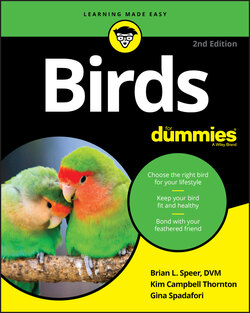Читать книгу Birds For Dummies - Gina Spadafori - Страница 16
Of song and speech
ОглавлениеBirds use song and mimicry to protect their territory, warn of danger, and attract mates, and throughout history, their fascinating music has also engaged a human audience. Such birds as the canary and the singing greenfinch have long been prized for their song, and the members of the Psittaciformes order — otherwise known as parrots — are so well known for their vocal talents that they’ve inspired a figure of speech. (To parrot something means to repeat it, whether you’re a bird or a human being.) Even finches such as the ones shown in Figure 1-1 keep up a companionable twittering.
Photograph courtesy of Claudia Hunka, Your Basic Bird (Berkeley, California)
FIGURE 1-1: The lively sounds and antics of little birds like this shaft-tail finch add to their wide appeal.
The breeding of canaries dates to the 16th century, and humans’ relationship with wild-caught parrots is traceable to even earlier times. Ancient Greeks and Romans fell in love with parrots, so much so that a trained one was considered more valuable than the slave who trained him. A favorite phrase to teach a Roman parrot? Why, “Hail the Emperor!,” of course.
Some 1,800 years later, companion birds were still found in the highest halls of government. Yes, the White House. James and Dolley Madison brought their “green parrot” with them to the Executive Mansion, Thomas Jefferson kept mockingbirds there, and Andrew Jackson had a parrot named Polly known for her (pardon the pun) “fowl” language. John Tyler had a pet canary he called Johnny Ty — nothing like naming a bird after yourself — and, of course, Abraham Lincoln is known for the earliest of the presidential turkey pardons. An admirer sent James Buchanan two bald eagles, whom he sent to live at his home in Pennsylvania. William McKinley had a parrot named Washington Post, known for whistling “Yankee Doodle.” Calvin Coolidge may well have had the greatest number of presidential pets, including four canaries, a thrush, a goose, a troupial (the national bird of Venezuela), a mockingbird, and a “yellow bird” named Goldy. Dwight Eisenhower’s parakeet, Gabby, died while he was in office and is buried on White House grounds, as is Caroline Kennedy’s pet canary.
Recent research strongly suggests that birds don’t, in fact, merely parrot, or repeat, what they hear — some understand the words they’re saying. The work of Dr. Irene Pepperberg and her African grey, Alex, changed everyone’s understanding of the intelligence of birds. Sadly, Alex passed away in his sleep at the young age of 31, as a result of atherosclerosis (hardening of the arteries), but his legacy continues to be a guiding light for us all. Alex didn’t just talk — he had the ability to identify objects and colors and understand concepts such as “bigger” and “smaller.” You can learn more about him at the Alex Foundation (www.alexfoundation.org).
